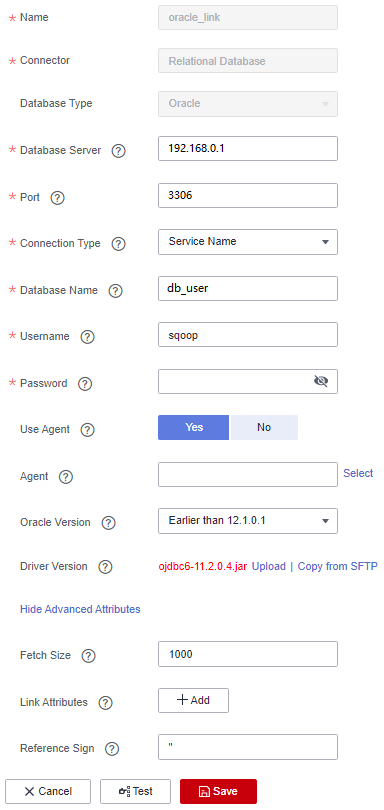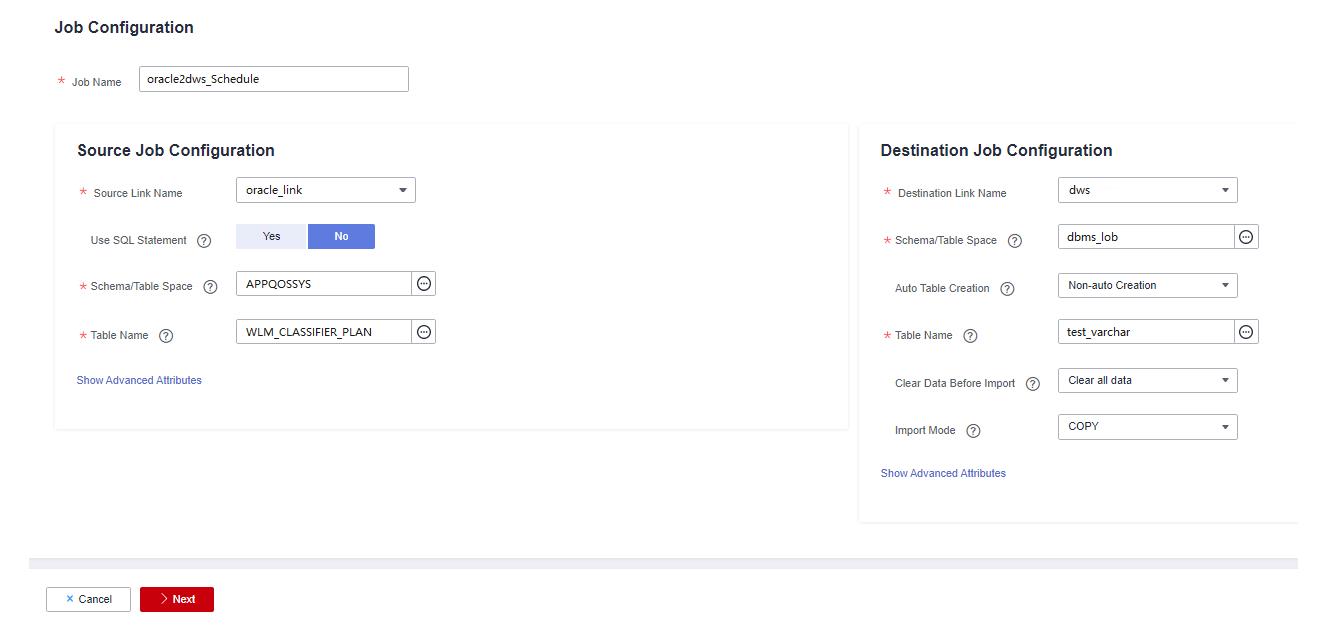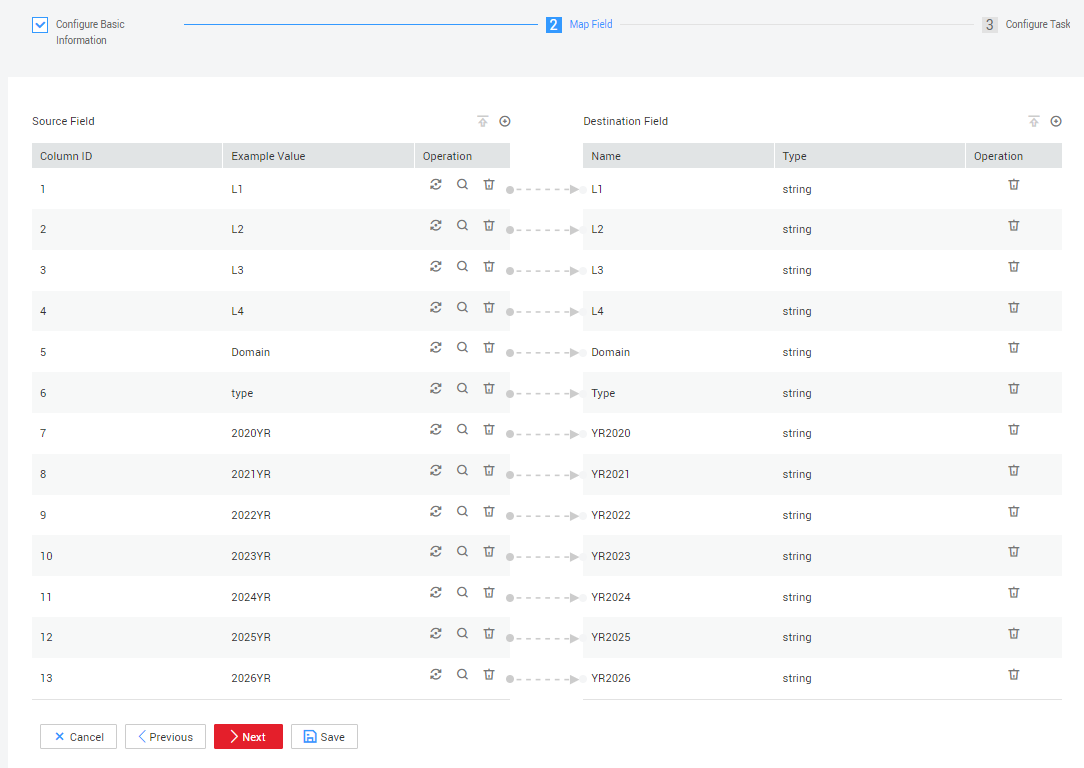Migrating Data from Oracle to DWS¶
Scenario¶
CDM supports table-to-table migration. This section describes how to use CDM to migrate data from Oracle to Data Warehouse Service (DWS). The procedure is as follows:
Prerequisites¶
You have obtained a DWS cluster and the IP address, port number, database name, username, and password for connecting to the DWS database. In addition, you must have the read, write, and delete permissions on the DWS database.
You have obtained the IP address, name, username, and password of the Oracle database.
If the Oracle database is deployed on an on-premises data center or a third-party cloud, ensure that an IP address that can be accessed from the public network has been configured for the Oracle database, or the VPN or Direct Connect between the on-premises data center and cloud has been established.
You have uploaded an Oracle database driver by following the instructions provided in Managing Drivers.
Creating a CDM Cluster and Binding an EIP to the Cluster¶
Create a CDM cluster by following the instructions in Creating a Cluster.
The key configurations are as follows:
The flavor of the CDM cluster is selected based on the amount of data to be migrated. Generally, cdm.medium meets the requirements for most migration scenarios.
The VPC, subnet, and security group of the CDM cluster must be the same as those of the DWS cluster.
If the same subnet and security group cannot be used, for security reasons, ensure that a security group rule has been configured to allow the CDM cluster to access the CSS cluster.
After the CDM cluster is created, locate the row that contains the cluster and click Bind EIP in the Operation column. (CDM uses an EIP to access the Oracle data source.)
Note
If SSL encryption is configured for the access channel of a local data source, CDM cannot connect to the data source using the EIP.
Creating an Oracle Link¶
Click Job Management in the Operation column of the CDM cluster. On the displayed page, click the Links tab and then Create Link. The Select Connector page is displayed.

Figure 1 Selecting a connector type¶
Select Oracle and click Next to configure parameters for the link.

Figure 2 Creating an Oracle link¶
Table 1 Oracle link parameters¶ Parameter
Description
Example Value
Name
Enter a unique link name.
oracle_link
Database Server
Database server domain name or IP address
192.168.0.1
Port
Oracle database port
3306
Connection Type
Type of the Oracle database link
Service Name
Database Name
Name of the database to be connected
db_user
Username
User who has the read permission of the Oracle database
admin
Password
Password used for logging in to the Oracle database
-Use Agent
Whether to extract data from the data source through an agent
Yes
Agent
Click Select and select the agent created in Connecting to an Agent.
-Oracle Version
The latest version is used by default. If the version is incompatible, select another version.
Later than 12.1
Driver Version
A driver version that adapts to the Oracle database
-Fetch Size
Number of rows obtained by each request
1000
Link Attributes
Custom attributes of the link
useCompression=true
Reference Sign
Delimiter used to separate referenced table names or column names This parameter is left blank by default.
'
Click Save. The Links page is displayed.
Creating a DWS Link¶
Click Job Management in the Operation column of the CDM cluster. On the displayed page, click the Links tab and then Create Link. The Select Connector page is displayed.
Select Data Warehouse Service and click Next to configure the DWS link parameters. Set the mandatory parameters listed in Table 2 and retain the default values for the optional parameters.
Table 2 DWS link parameters¶ Parameter
Description
Example Value
Name
Enter a unique link name.
dwslink
Database Server
IP address or domain name of the DWS database
192.168.0.3
Port
DWS database port
8000
Database Name
Name of the DWS database
db_demo
Username
User who has the read, write, and delete permissions on the DWS database
dbadmin
Password
Password of the user
-Use Agent
Whether to extract data from the data source through an agent
Yes
Agent
Click Select and select the agent created in Connecting to an Agent.
-Import Mode
COPY: Migrate the source data to the DWS management node and then copy the data to DataNodes. To access DWS through the Internet, select COPY.
COPY
Click Save.
Creating a Migration Job¶
Choose Table/File Migration > Create Job to create a job for exporting data from the Oracle database to DWS.

Figure 3 Creating a job for migrating data from Oracle to DWS¶
Job Name: Enter a unique name.
Source Job Configuration
Source Link Name: Select the oracle_link created in Creating an Oracle Link.
Schema/Tablespace: Enter the name of the database whose data is to be migrated.
Table Name: Enter the name of the table whose data is to be migrated.
Retain the default values of the optional parameters in Show Advanced Attributes. For details, see From a Common Relational Database.
Destination Job Configuration
Destination Link Name: Select the dwslink created in Creating a DWS Link.
Schema/Tablespace: Select the DWS database to which data is to be written.
Auto Table Creation: This parameter is displayed only when both the migration source and destination are relational databases.
Table Name: Name of the table to which data is to be written. You can enter a table name that does not exist. CDM automatically creates the table in DWS.
Orientation: You can create row- or column-store tables as needed. Generally, if a table contains many columns (called a wide table) and its query involves only a few columns, column storage is recommended. If a table contains only a few columns and a query includes most of the fields, row storage is recommended.
Extend char length: If the data encoding formats of the migration source and destination are different, the character length of the automatic table creation may be insufficient. If you select Yes for this parameter, the character length will be increased by three times during automatic table creation.
Clear Data Before Import: whether to clear data in the destination table before the migration task starts.
Click Next. The Map Field page is displayed. CDM automatically matches the source and destination fields, as shown in Figure 4.
If the field mapping is incorrect, you can drag the fields to adjust the mapping.
You can map fields in batches.
The expressions in CDM support field conversion of common character strings, dates, and values.

Figure 4 Table-to-table field mapping¶
Click Next and set task parameters. Generally, retain the default values of all parameters.
In this step, you can configure the following optional functions:
Retry Upon Failure: If the job fails to be executed, you can determine whether to automatically retry. Retain the default value Never.
Group: Select the group to which the job belongs. The default group is DEFAULT. On the Job Management page, jobs can be displayed, started, or exported by group.
Schedule Execution: To configure scheduled jobs, see Scheduling Job Execution. Retain the default value No.
Concurrent Extractors: Enter the number of extractors to be concurrently executed. You can increase the value of this parameter to improve migration efficiency.
Write Dirty Data: Dirty data may be generated during data migration between tables. You are advised to select Yes.
Delete Job After Completion: Retain the default value Do not delete.
Click Save and Run. The Job Management page is displayed, on which you can view the job execution progress and result.
After the job is successfully executed, in the Operation column of the job, click Historical Record to view the job's historical execution records and read/write statistics.
On the Historical Record page, click Log to view the job logs.
Note
If the migration times out because writing data to the destination costs a long time, reduce the value of the Fetch Size parameter.